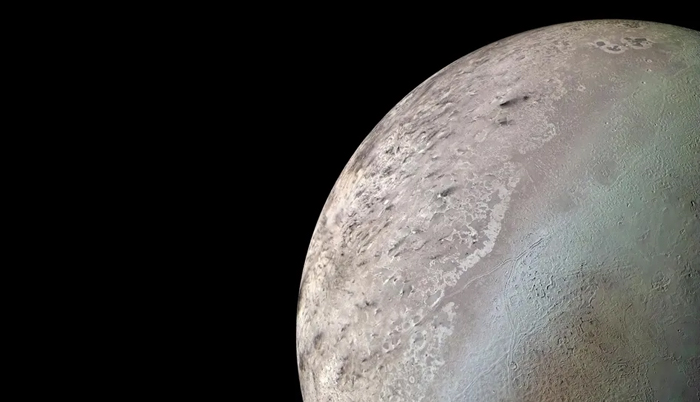![]() Home > Space & Science
Home > Space & Science
Why Is Neptune's Moon Triton So Weird?

An enhanced view of Neptune's largest moon, Triton. (Image credit: NASA/JPL/USGS)
![]() September 16th, 2023 | 11:47 AM |
September 16th, 2023 | 11:47 AM | ![]() 663 views
663 views
ENGADGET
Triton orbits to the beat of its own drum.
Sometimes, astronomy is like a forensic investigation: We can't just rerun the past, so we have to study clues to figure out what happened. And the outer solar system contains one striking crime scene holding a big mystery: How the environment around Neptune got a moon like Triton.
Neptune has 14 known moons. With the exception of Triton, all of Neptune's moons are very small, and they come in two general flavors: regular and irregular. The regular ones orbit close to the planet, and the irregular ones are generally farther from Neptune, with all sorts of crazy orbits.
And then there's Triton. It was discovered by English merchant and amateur astronomer William Lassell, who, in 1846, spotted the moon a mere 17 days after the discovery of Neptune itself. But it wasn't until Aug. 25, 1989, that we got our first close-up look at Triton when the Voyager 2 probe flew by on the last leg of its historic "grand tour" of the outer solar system. Although Voyager 2 mapped only 40% of Triton's surface, the mission revealed just how strange the Neptunian moon is.
For one, Triton is big. It's the seventh-largest moon in the solar system, and it's over 200 times bigger than all of the other moons of Neptune combined, which makes it really stick out.
Second, Triton is one of the irregular moons. It orbits backward relative to Neptune's spin, and its orbit is inclined at a stunning 67 degrees — almost perpendicular to its parent planet. Despite its irregularity, Triton's orbit is surprisingly circular — in fact, one of the most perfectly circular orbits out of all the objects in the solar system.
As for the surface, it looks like a cantaloupe. A large chunk of Triton's midlatitudes is covered in bumpy, wrinkly features nicknamed, appropriately enough, cantaloupe terrain. Another large section features broad, featureless plains dotted with massive calderas, while the southern portion is dominated by a vast nitrogen ice cap, dotted with dozens of cryovolcanoes — volcanoes that spew jets of water.
What the surface of Triton doesn't have is a lot of craters, signifying that it's capable of resurfacing itself and erasing them. That ability to resurface is uncommon in the solar system, and it's a sign that the moon is still partially warm.
So we've gathered the facts of the crime scene investigation: This moon of Neptune is way bigger than it should be, has a completely wonky orbit, formed in a nontraditional way, and has a young, dynamic and active surface.
What's the story behind these oddities? The best answer is that Triton is no mere moon but instead a victim of an interplanetary kidnapping. Perhaps it is really a Kuiper Belt object more akin to Pluto or Eris than to the other moons of the solar system. Perhaps long ago, Triton fell into the vicinity of Neptune, got captured by the planet's gravity and was forced to spend the remaining billions of years in orbit in its unwelcome home.
Either Triton just got unlucky and had the exact wrong orbit to land itself near Neptune, or it suffered some fateful collision with one of Neptune's original moons and, in the process, lost enough energy to remain in orbit. Another possibility is that Triton originally formed as a small binary system, much like many other Kuiper Belt objects, and a close encounter with Neptune sent Triton's twin flying away and left Triton itself trapped.
The capturing of Triton explains its strange orbit. If it didn't form organically in the Neptunian system, it would have no reason to share the orbital plane with the regular moons. And if it was captured early enough, it would have had to swim through the debris surrounding the still-forming Neptune, which would be enough to shape its orbit into a nearly perfect circle.
Triton remains warm because, like other Kuiper Belt objects, it has enough radioactive elements to release heat. That heat turns water, carbon dioxide and nitrogen ices into slush, keeping the surface young and active (much like Pluto has a giant, slushy, nitrogen-ice glacier field). Indeed, Triton may be so warm that it sports a liquid water ocean underneath its crust.
It's been over a generation since our last, brief encounter with Triton. Those images captured by Voyager 2 are the only ones we have. Unfortunately, no mission concepts to return to the Neptunian system have advanced past the proposal stage within NASA's funding structure. Given the agency's interest in the moons of Jupiter and Saturn (which, to be fair, also are homes to vast oceans of liquid water and are far, far closer than Neptune), there will likely be no follow-up mission in our lifetimes.
And so this crime scene will have to wait until the next generation of explorers to be fully investigated.
Source:
courtesy of SPACE
by Paul Sutter
If you have any stories or news that you would like to share with the global online community, please feel free to share it with us by contacting us directly at [email protected]